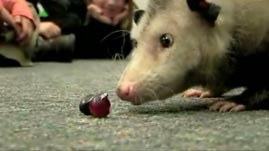Teachers' Domain - Digital Media for the Classroom and Professional Development
User: Preview


Source: Curious George, © 2006 Universal Studios. All rights reserved.
This video from Curious George introduces students to the importance of skins, peels, and other fruit coverings, which help protect a fruit's precious cargo: seeds. Seeds are a plant's offspring. For plants to survive, they must distribute their seeds in places where they stand a good chance of growing. Fruits are part of a plant's reproductive strategy. The teacher explains to the students that ripe fruit is more attractive to animals. This is important, as fruit-eating animals transport seeds contained inside fruit to other places, where they are deposited and subsequently germinate.
Plants have evolved an amazing variety of adaptations to succeed in the struggle for survival. Millions of years of evolution have shaped their form and function. Many plant flowers, including the sunflower seen in the video, lure insects and birds with rewards of pollen and nectar. In exchange, these animals unknowingly carry pollen to other flowers and fertilize the eggs they contain, thus ensuring reproduction of the plant species. However, one of the most effective evolutionary adaptations of plants is seed dispersal, or the scattering of offspring far away from the parent plant. The effects are two-fold: Dispersal puts seeds in a potentially better growing environment, and it reduces the competition for resources with the parent plant.
The fruit of some plants attracts animals that in turn disperse seeds. A fruit is the ripened ovary of a plant that contains seeds. After a plant egg is fertilized, the ovary swells and becomes either fleshy, as in berries, or hard and dry, as in nuts, to protect the developing seeds. The seeds develop in the fruit until they can begin to grow.
As fruit ripen, they develop an odor and appearance that will attract animals. A plant hormone called ethylene causes ripening. For example, it turns bananas and pears from bitter and green into sweet and yellow. After an animal eats ripened fruit and it travels through the digestive system, the fruit's seeds are dispersed wherever the animal defecates.
Not all plants employ fruits to transport their seeds. Some produce seeds with hooks, barbs, and burrs on their surfaces. These "hitchhikers" may attach to an animal's hair in one field and be transported to another field miles away. Wind and water are other effective seed-dispersal agents. A single gust of wind can carry hundreds of thousands of dandelion seeds from one field to the next. Similarly, ocean currents are capable of transporting plant seeds between continents.
 Loading Standards
Loading Standards Teachers' Domain is proud to be a Pathways portal to the National Science Digital Library.
Teachers' Domain is proud to be a Pathways portal to the National Science Digital Library.
